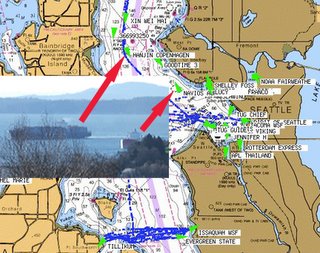Has my Ship Come in?
 On a busy day in Puget Sound, it seems like the freighters and tugs go by at 10 minute increments. As I look out the window I often wonder what the names of the ships are.
On a busy day in Puget Sound, it seems like the freighters and tugs go by at 10 minute increments. As I look out the window I often wonder what the names of the ships are.UAIS (Universal Automatic Identification system) is all the rage among geeky boat owners of any size in busy shipping lanes. With a system of a receiver, antenna, and a display or laptop computer with navigation software, you can see most of the large or passenger carrying vessels and a lot of information about them. If you have a GPS you can determine your closest approach, etc. This is in many ways much better than radar and a fraction of the cost. a system for a small sailboat like mine is maybe $3-400. The USCG has a section describing AIS and Panbo's Marine Electronics Blog has many articles on this new service.
Enter Sea Links. From their website; "SEALINKS operates the world's first live AIS-to-Web network and is currently tracking AIS activity with RADARPLUS SL161R units installed around Puget Sound, Washington, USA. The network is expanding to include additional ports throughout the United States and around the globe. It looks like they also have the upper east coast covered now.
By going to these websites you can get a chart display of the ship's names, tracks, and other info from the internet. So I can pull up a page and say to myself; "Hmm, that's the Hajin Copenhagen going by. I wonder why the Navios Aurora has been anchored out there for two days..."
I'll eventually add this equipment to my boat, although my home port of Blaine isn't in the busiest shipping area, most of the ships run to the west.













